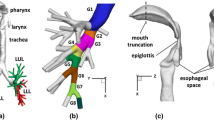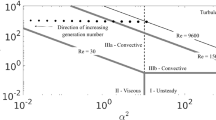Abstract
The flow in an idealized airway model is investigated for the steady inhalation case. The geometry consists of a symmetric planar double bifurcation that reflects the anatomical proportions of the human bronchial tree, and a wide range of physiologically relevant Reynolds numbers (Re = 100–5000) is considered. Using magnetic resonance velocimetry, we analyze the three-dimensional fields of velocity and vorticity, along with flow descriptors that characterize the longitudinal and lateral dispersion. In agreement with previous studies, the symmetry of the flow partitioning is broken even at the lower Reynolds numbers, and at the second bifurcation, the fluid favors the medial branches over the lateral ones. This trend reaches a plateau around Re = 2000, above which the turbulent inflow results in smoothed mean velocity gradients. This also reduces the streamwise momentum flux, which is a measure of the longitudinal dispersion by the mean flow. The classic Dean-type counter-rotating vortices are observed in the first-generation daughter branches as a result of the local curvature. In the granddaughter branches, however, the secondary flows are determined by the local curvature only for the lower flow regimes (Re ≤ 250), in which case the classic Dean mechanism prevails. At higher flow regimes, the field is instead dominated by streamwise vortices extending from the daughter into the medial granddaughter branches, where they rotate in the opposite direction with respect to Dean vortices. Circulation and secondary flow intensity show a similar trend as the momentum flux, increasing with Reynolds number up to Re = 2000 and then dropping due to turbulent dissipation of vorticity. The streamwise vortices interact both with each other and with the airway walls, and for Re > 500 they can become stronger in the medial granddaughter than in the upstream daughter branches. With respect to realistic airway models, the idealized geometry produces weaker secondary flows, suggesting that realistic anatomical features may generate more lateral dispersion than canonical symmetric models.














Similar content being viewed by others
References
Andrade JS Jr, Alencar AM, Almeida MP, Mendes Filho J, Buldyrev SV, Zapperi S, Suki B (1998) Asymmetric flow in symmetric branched structures. Phys Rev Lett 81(4):926
Banko AJ, Coletti F, Schiavazzi D, Elkins CJ, Eaton JK (2015) Three-dimensional inspiratory flow in the upper and central human airways. Exp Fluids 56(6):1–12
Benson MJ, Elkins CJ, Eaton JK (2011) Measurements of 3D velocity and scalar field for a film-cooled airfoil trailing edge. Exp Fluids 51(2):443–455
Bulusu KV, Hussain S, Plesniak MW (2014) Determination of secondary flow morphologies by wavelet analysis in a curved artery model with physiological inflow. Exp Fluids 55(11):1–20
Caro CG, Doorly DJ, Tarnawski M, Scott KT, Long Q, Dumoulin CL (1996) Non-planar curvature and branching of arteries and non-planar-type flow. In: proceedings of the Royal Society of London A: Mathematical, Physical and Engineering Sciences, vol 452(1944), The Royal Society, pp 185–197
Coletti F, Elkins CJ, Eaton JK (2013) An inclined jet in crossflow under the effect of streamwise pressure gradients. Exp Fluids 54(9):1–16
Comer JK, Kleinstreuer C, Zhang Z (2001) Flow structures and particle deposition patterns in double-bifurcation airway models. Part 1. Air flow fields. J Fluid Mech 435:25–54
Dean WR (1927) Note on the motion of fluid in a curved pipe. Lond Edinb Dublin Philos Mag J Sci 4(20):208–223
Doorly D, Sherwin S (2010) Geometry and flow. In: Formaggia L, Quarteroni A, Veneziani A (eds) Cardiovascular Mathematics: modeling and simulation of the circulatory system. Springer-Verlag, Milan, pp 177–209
Elkins CJ, Alley MT (2007) Magnetic resonance velocimetry: applications of magnetic resonance imaging in the measurement of fluid motion. Exp Fluids 43(6):823–858
Fredberg JJ (1980) Augmented diffusion in the airways can support pulmonary gas exchange. J Appl Physiol 49(2):232–238
Fresconi FE, Prasad AK (2007) Secondary velocity fields in the conducting airways of the human lung. J Biomech Eng 129(5):722–732
Glycerine Producers’ Association (1963) Physical properties of glycerine and its solutions. Glycerine Producers’ Association
Golshahi L, Finlay WH (2009) Recent advances in understanding gas and aerosol transport in the lungs: application to predictions of regional deposition. In: Wang LQ (ed) Advances in Transport Phenomena. Springer Berlin, Heidelberg, pp 1–30
Graftieaux L, Michard M, Grosjean N (2001) Combining PIV, POD and vortex identification algorithms for the study of unsteady turbulent swirling flows. Meas Sci Technol 12(9):1422
Grotberg JB (2001) Respiratory fluid mechanics and transport processes. Annu Rev Biomed Eng 3(1):421–457
Haacke M, Brown R, Thompson M, Venkatesan R (1999) Magnetic Resonance Imaging. Wiley-Liss, New York
Isabey D, Chang HK (1982) A model study of flow dynamics in human central airways. Part II: secondary flow velocities. Respir Physiol 49(1):97–113
Kleinstreuer C, Feng Y (2013) Computational analysis of non-spherical particle transport and deposition in shear flow with application to lung aerosol dynamics—a review. J Biomech Eng 135(2):021008
Kleinstreuer C, Zhang Z (2010) Airflow and particle transport in the human respiratory system. Annu Rev Fluid Mech 42:301–334
Leong FY, Smith KA, Wang CH (2009) Secondary flow behavior in a double bifurcation. Phys Fluids (1994-present) 21(4):043601
Liu Y, So RMC, Zhang CH (2002) Modeling the bifurcating flow in a human lung airway. J Biomech 35(4):465–473
Longest PW, Vinchurkar S (2007) Validating CFD predictions of respiratory aerosol deposition: effects of upstream transition and turbulence. J Biomech 40(2):305–316
Markl M, Frydrychowicz A, Kozerke S, Hope M, Wieben O (2012) 4D flow MRI. J Magn Reson Imaging 36(5):1015–1036
Mauroy B, Filoche M, Andrade JS Jr, Sapoval B (2003) Interplay between geometry and flow distribution in an airway tree. Phys Rev Lett 90(14):148101
Mauroy B, Filoche M, Weibel ER, Sapoval B (2004) An optimal bronchial tree may be dangerous. Nature 427(6975):633–636
Murray CD (1926) The physiological principle of minimum work I. The vascular system and the cost of blood volume. Proc Natl Acad Sci 12(3):207–214
Padilla A (2012) The effect of upstream perturbations on 3D annular diffusers. PhD thesis, Stanford University
Pedley TJ (1977) Pulmonary fluid dynamics. Annu Rev Fluid Mech 9(1):229–274
Pedley TJ, Schroter RC, Sudlow MF (1970) The prediction of pressure drop and variation of resistance within the human bronchial airways. Respir Physiol 9(3):387–405
Pedley TJ, Schroter RC, Sudlow MF (1971) Flow and pressure drop in systems of repeatedly branching tubes. J Fluid Mech 46(02):365–383
Pelc NJ, Sommer FG, Li KC, Brosnan TJ, Herfkens RJ, Enzmann DR (1994) Quantitative magnetic resonance flow imaging. Magn Reson Q 10(3):125–147
Pope SB (2000) Turbulent flows. Cambridge University Press, Cambridge
Sapoval B, Filoche M (2013) Magic trees in mammalians respiration or when evolution selected clever physical systems. Fractals 21(03n04):1350024
Schroter RC, Sudlow MF (1969) Flow patterns in models of the human bronchial airways. Respir Physiol 7(3):341–355
Theunissen R, Riethmuller ML (2007) Particle image velocimetry in lung bifurcation models. In: Particle Image Velocimetry. Springer, Berlin, Heidelberg, pp 73–101
Weibel ER (1984) The pathway for oxygen: structure and function in the mammalian respiratory system. Harvard University Press, Cambridge, MA
Weibel ER (1963) Principles and methods for the morphometric study of the lung and other organs. Lab Investig J Tech Methods Pathol 12:131
Weibel ER (1997) Design of airways and blood vessels considered as branching tree, Chapter 74. In: Crystal RG, West JB, Barnes PJ (eds) The Lung. Lippencott-Raven Inc., Philadelphia
Zhang Z, Kleinstreuer C (2002) Transient airflow structures and particle transport in a sequentially branching lung airway model. Phys Fluids (1994-present) 14(2):862–880
Zhao Y, Lieber BB (1994) Steady inspiratory flow in a model symmetric bifurcation. J Biomech Eng 116(4):488–496
Acknowledgments
Funding for this work was provided by the National Science Foundation (Chemical, Bioengineering, Environmental, and Transport Systems, Grant #1453538). We wish to thank Ute Goerke (Center for Magnetic Resonance Research, University of Minnesota) for continuous support in operating the MRI scanner, Clement Kleinstreuer (North Carolina State University) for kindly providing the bifurcation geometry, and Azar Eslam-Panah (Pennsylvania State University) for many helpful discussions on vortex identification and tracking.
Author information
Authors and Affiliations
Corresponding author
Rights and permissions
About this article
Cite this article
Jalal, S., Nemes, A., Van de Moortele, T. et al. Three-dimensional inspiratory flow in a double bifurcation airway model. Exp Fluids 57, 148 (2016). https://doi.org/10.1007/s00348-016-2234-5
Received:
Revised:
Accepted:
Published:
DOI: https://doi.org/10.1007/s00348-016-2234-5




